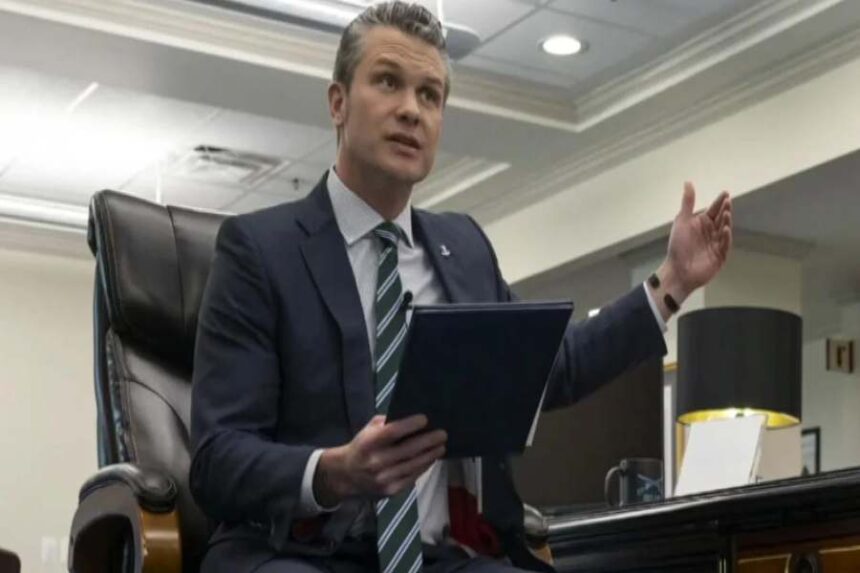The Pentagon established a specialized system inside Defense Secretary Pete Hegseth’s office that allowed him to view messages from the encrypted app Signal, according to multiple sources familiar with the matter. The move, which reportedly bypassed standard Department of Defense (DoD) cybersecurity protocols, has sparked significant concerns among national security officials about potential vulnerabilities within one of the nation’s most sensitive secure environments.
Sources confirmed to CBS News that the system enabled Hegseth to monitor and respond to Signal messages from his personal iPhone, even though the device remained outside the secured Sensitive Compartmented Information Facility (SCIF). Typically, SCIF protocols strictly prohibit personal electronic devices due to the high risk of eavesdropping and cyber infiltration.
A computer monitor was installed in Hegseth’s office to display incoming Signal messages linked remotely to his cellphone, allowing him to observe messages without physically bringing the device into the secured area. Defense Department officials pushed back on reports suggesting a major security breach, stating that the system functions strictly as a “one-way line”—the monitor simply alerts Hegseth to incoming communications without enabling full interactivity. Officials also denied the existence of a so-called “dirty line,” an unsecured internet connection vulnerable to external attacks, within the Secretary’s office.
Despite these reassurances, sources familiar with the setup expressed concern, noting that even limited visibility into personal communications within a SCIF presents a significant security risk. They emphasized that the system was not connected to the military’s Non-Secure Internet Protocol Router Network (NIPRNet), and that the ability to view encrypted personal messages inside a sensitive government facility represents a potential breach of cybersecurity protocols.
The controversy surrounding Hegseth’s communications practices deepened earlier this week following reports that he had shared details of impending U.S. airstrikes in Yemen within private Signal group chats. Those chats reportedly included his wife, his brother, and his personal attorney. While the brother and attorney hold positions within the Pentagon, their roles allegedly do not require access to operational military plans, raising questions about unauthorized dissemination of sensitive information. This disclosure marked the second time Hegseth reportedly used Signal to share classified operational information with individuals lacking the appropriate security clearances.
Sources indicated that Marine Colonel Ricky Buria, an aide in Hegseth’s office, played a key role in establishing the Signal access system. Buria, who was tasked with resolving internet connectivity issues in the early days of the administration, reportedly supervised aspects of the workaround installation. The Defense Department declined to comment on Buria’s involvement.
The Signal desktop application, which pairs with a user’s mobile phone through a QR code to mirror communications, enabled this remote monitoring setup. Although designed for convenience, the application’s introduction into a SCIF environment bypassed multiple layers of traditional security protections designed to shield sensitive information from exposure.
This situation underscores growing tensions within government and military circles about balancing operational convenience with strict cybersecurity measures. In an age where encrypted personal communication platforms are widely used, incidents like this raise broader questions about the adequacy of current cybersecurity policies at the highest levels of government.
As scrutiny mounts, calls for an internal review or an independent investigation into Hegseth’s communications practices are increasingly likely. Lawmakers on defense oversight committees may push for formal briefings to understand how security protocols were adapted and whether any classified information was compromised. While the Pentagon maintains that no breach has officially occurred, concerns persist regarding the precedent this situation sets and the future of secure communication practices among senior U.S. officials.
Readers concerned about the national security implications may ask: what exactly happened, why does it matter, and what happens next? In short, the Pentagon’s accommodation of Signal messaging access for the Secretary inside a SCIF represents an unprecedented security flexibility that experts warn could introduce new risks. The issue now is not just about Secretary Hegseth’s actions but about how evolving digital communication habits challenge the traditional boundaries of security in American defense leadership.




